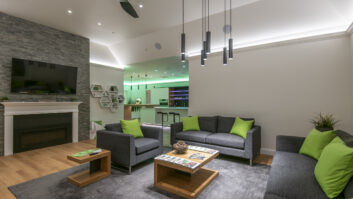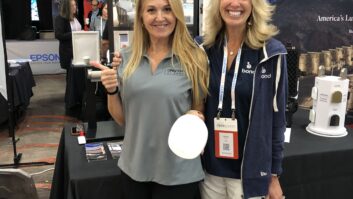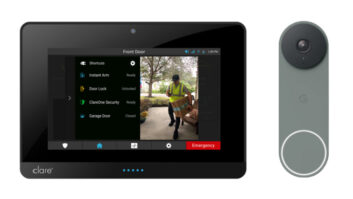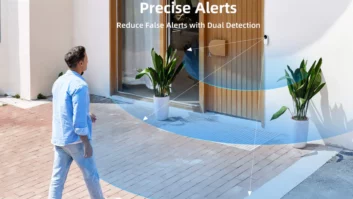Home Control Systems Integration Opens Doors For Installers
Wireless home-automation solutions are putting in a strong showing at this year’s CEDIA Expo, with multiple companies showing Z-Wave and Wi-Fi-based solutions marketed as a step up from wireless DIY solutions.
Many of the wireless products integrate with home-control systems that require professional installation and configuration, enabling integrators to differentiate their wireless products from those sold at home-improvement stores. Many wireless devices, for example, are controlled with in-wall touchpanels that require installation and professional set-up, though some can be controlled from hand-held remotes.
Here’s what integrators will find at the show:
Anuva Automation: The company is coming to the show to demonstrate recent upgrades to its TiO wireless multizone audio and wireless home-control system.
The upgrades include new hardware and integration with third-party systems, including the Nest thermostat.
TiO uses Wi-Fi for wireless control of light switches, dimmers, thermostats and wireless audio-zone players. Home systems are controlled from in-wall Wi-Fi touchscreens and from iOS and Android smartphones and tablets. The zone players incorporate networked streaming and amplifiers. Two models install in the wall and feature integrated touchscreen for control. Another player lacks touchscreen and is designed to be hidden away.
All of the products communicate via a TiO Wi-Fi access point that creates a subnetwork for TiO systems.
Other upgrades include operation from both Android and Apple tablets and improvements in TiO Pro software, which is hidden inside the Android app to set up systems. Pro also added network signal-strength meters and other system diagnostics tools to simplify setup.
H-P Products: The central-vacuum company is announcing a distribution agreement with SEBO to provide U.S. central-vacuum dealers with two new SEBO electric powerheads. The Acclaim by SEBO models weigh less than six pounds.
Both the Acclaim 12 and Acclaim 15 electric powerheads generate 2700 RPMs of brush speed and offer four height levels. Their high-speed brush rollers deep-clean floors with double-rows of long-wearing bristles, and a 180-degree swivel neck is designed to get around corners and objects, the companies said.
The powerheads are fitted with thick rubber wheels and bumpers to protect against denting or scratching of household objects. The powerheads also self-diagnose potential maintenance issues.
The company also announced upgrades to its “Dealer First” program, adding new services such as consumer sales videos, a website builder program, custom literature design, additional field training options, and a builder rebates program.
They’re part of an effort to develop different approaches to selling central vacuum installations to different generations. As part of that effort, H-P developed a smart-home approach to selling central vacuums, likening the placement of retractable hoses to the additional convenience offered by connected lightbulbs and thermostats, the company said.
H-P has also stepped up its builder-channel commitment by participating in the Home Builder Association (HBA) Rebates program, which rewards builders and integrators who regularly install central vacuum systems. The association represents small to mid-size builders and remodelers that make up a large percentage of the overall building sector, H-P said.
Lucis Technologies: The Sunnyvale, Calif., company is bringing its newest home-automation touchscreen controller to the show. The $199 Wi-Fi-equipped Nu- Bryte Touchpoint on-wall touchscreen replaces one- or two-gang switch boxes in each room in which users want to control lighting and view security-camera video from an iOS device. An Android app is in the works.
The $199 5-inch 16:9 touchscreen controls the lights that were controlled by the mechanical light switches that it replaces. The console also incorporates security camera that sends alerts to a user’s mobile device when motion and sound are detected.
Via motion sensors, it also turns lights on and off as users leave or enter rooms, and it turns off lights when users leave the home. It also adjusts lights automatically based on household living patterns.
The console can also be used as an intercom, and it monitors energy use by a home’s lights.
Besides motion detector, it comes with humidity and temperature sensors, and it delivers weather forecasts.
Orvito: The company’s Spindle universal-remote device enables remote IR control of home entertainment and other IR-controlled devices from an iOS smartphone or tablet.
The Spindle is a Wi-Fi-equipped tabletop device with IR blaster with wide-angle dispersion to control multiple devices in a room over long distances, the company said. It also displays a location-based channel guide on a user’s iOS device and enables social-media integration, showing friends what you’re watching.
Orvito offers home and business automation products based on a controller running on the proprietary Nucleo platform. The controller controls such devices as thermostats, lights and baby monitors. Controlled products include Orvito’s Smart Switch Panel (Switch), Video Doorbell (Perch), and surveillance cameras as well as third-party products. The controller also acts as a gateway to the Cloud.
RTI: The company is launching its first Z-Wave lighting products under its RTI and Pro Control brands. They’re due in 2016. The company is also launching a new RTI intercom capability.
All-new Z-Wave lighting-control solutions let users control lights locally or from an RTI or Pro Control UI. The RTI lighting products integrate with RTI’s home and commercial automation systems via the ZW-9 Z-Wave interface module for new construction and retrofit installations.
The line consists of light switches, dimmers, a lamp module and receptacles. It also comes with battery-operated Anyplace switch requiring no wiring of any kind.
The Pro Control Z-Wave lighting products, including an Anyplace switch, interfaces with Pro’s Pro.zwi Z-Wave interface module.
Also new is a new intercom capability available as a free firmware update due in the fourth quarter. It provides an audio intercom solution between RTI user interfaces and any third-party device that supports intercom functionalities via SIP protocol. The capability enables auto answer and do-not-disturb functions, device-to-device calling, and a simple page flip to access the intercom on supported RTI interfaces. The interfaces include the T3x handheld remote, CX7 countertop/ under-cabinet touchpanel, and KX7, KX3 and KX10 in-wall touchpanels.
The interfaces offer a “push-to-talk” mode. RTI’s new intercom capability is available as a free firmware update.
URC: New one- and two-way remotes, a new Z-Wave gateway, and new SKUs for the company’s wireless Vivido lighting-control system are on tap.
The new MX-990 remote for the company’s Complete Control home-automation systems is positioned as the company’s most advanced one-way IR/RF remote, which features color 2.4-inch touchscreen with customizable on-screen graphics. It talks to the existing MRX-350 and MRF-260URC 418 MHz RF base stations.
The latest entry-level Total Control handheld remote is the $399-suggested TRC-820, designed to work with all URC System controllers, including the MRX-20,MRX-10 and new MRX-8. The two-way remote is Wi-Fi-based, whereas its predecessor communicated via proprietary 2.4GHz protocol. It features 2-inch color LCD screen.
The TRC-820 is available in a bundle with the MRX- 8 system controller at an entry-level price of less than $1,000. The controller can also be controlled from iOS and Android apps.
In new gateways, the TRF-ZW2 Wi-Fi-connected ZWave gateway is smaller and up to 20 percent faster than its predecessor, and it comes with a new GUI that lets consumers set their own lighting scenes quickly, the company said. It also comes with programming for URC’s Vivido lighting system. WPS (Wi-Fi Protected Setup) allows for pushbutton pairing. Connected ZWave devices can be controlled from offsite.
The company also announced shipments of the latest SKUs in its Vivido lighting-control system. The $145 Vivido wall-mount five-scene keypad and the appliance switching module join the RF Duplex receptacle, battery-operated switch/dimmer, and an assortment of dimmers and switches.
Vivido uses two-way Z-Wave and controls almost every type of dimmable bulb, including tungsten, halogen, LED, CFL, ELV and MLV bulbs.
The Vivido keypad mounts in a standard singlegang electrical box and is powered by normal household line voltage (120V/AC 60Hz). It activates up to five preset scenes when one of the five buttons on the keypad is pressed. Each button turns a different scene on and off. A blue LED on each button provides scene-status notification. The LEDs dim when a scene has been deactivated. Each scene can be brightened or dimmed by pressing and holding the button of an active scene.
The appliance switching module plugs into the wall and turns on/off any plugged-in device up to 600 watts, including appliances. The module provides programmable functions such as scenes, events, and child lockout when installed as part of a Total Control system. Plug-in modules can be manually and remotely controlled from URC and other Z-Wave controllers or programs.













